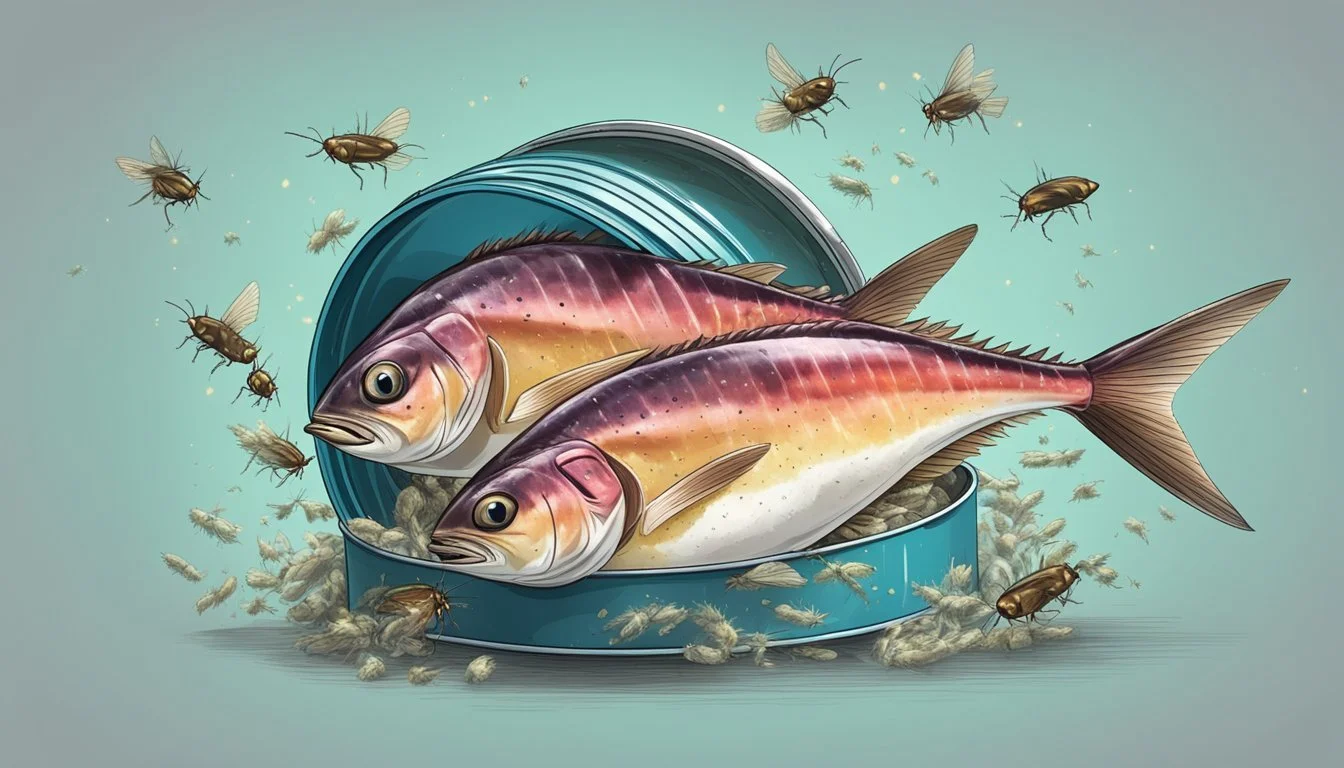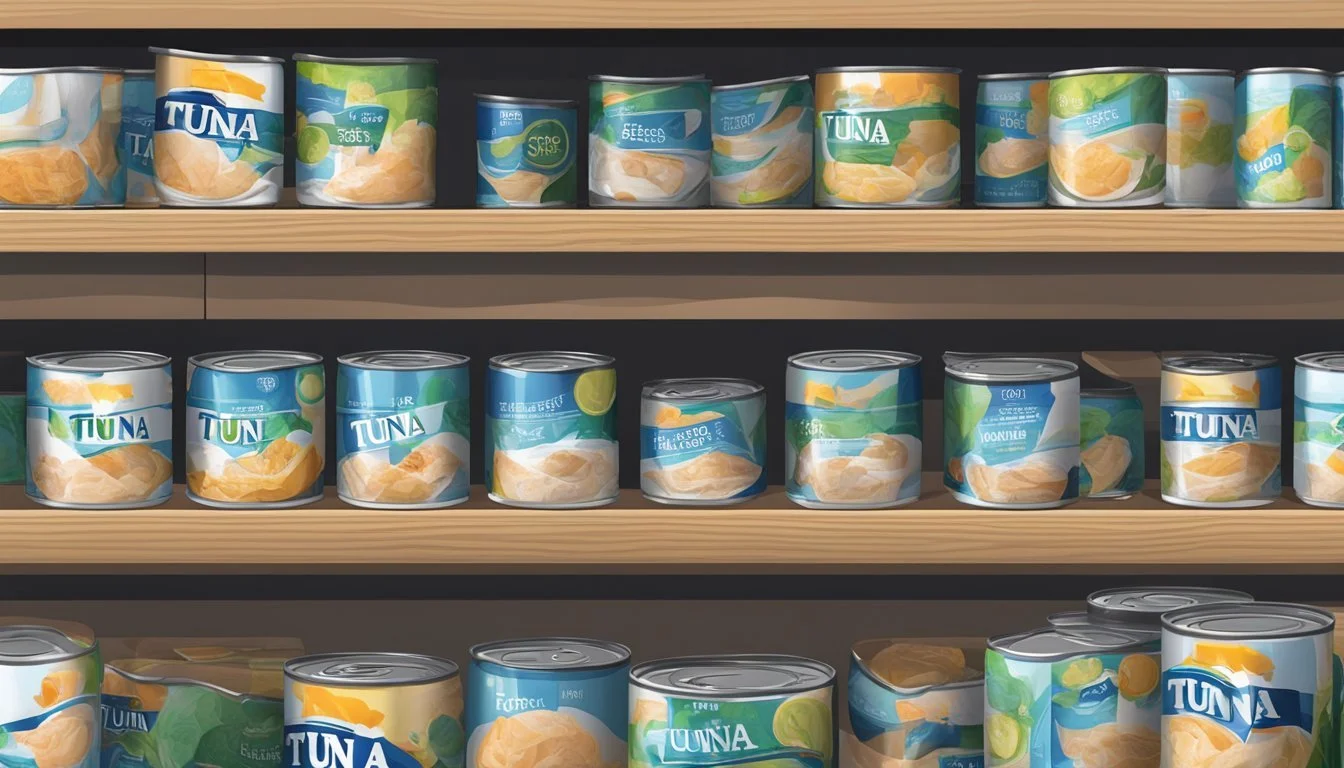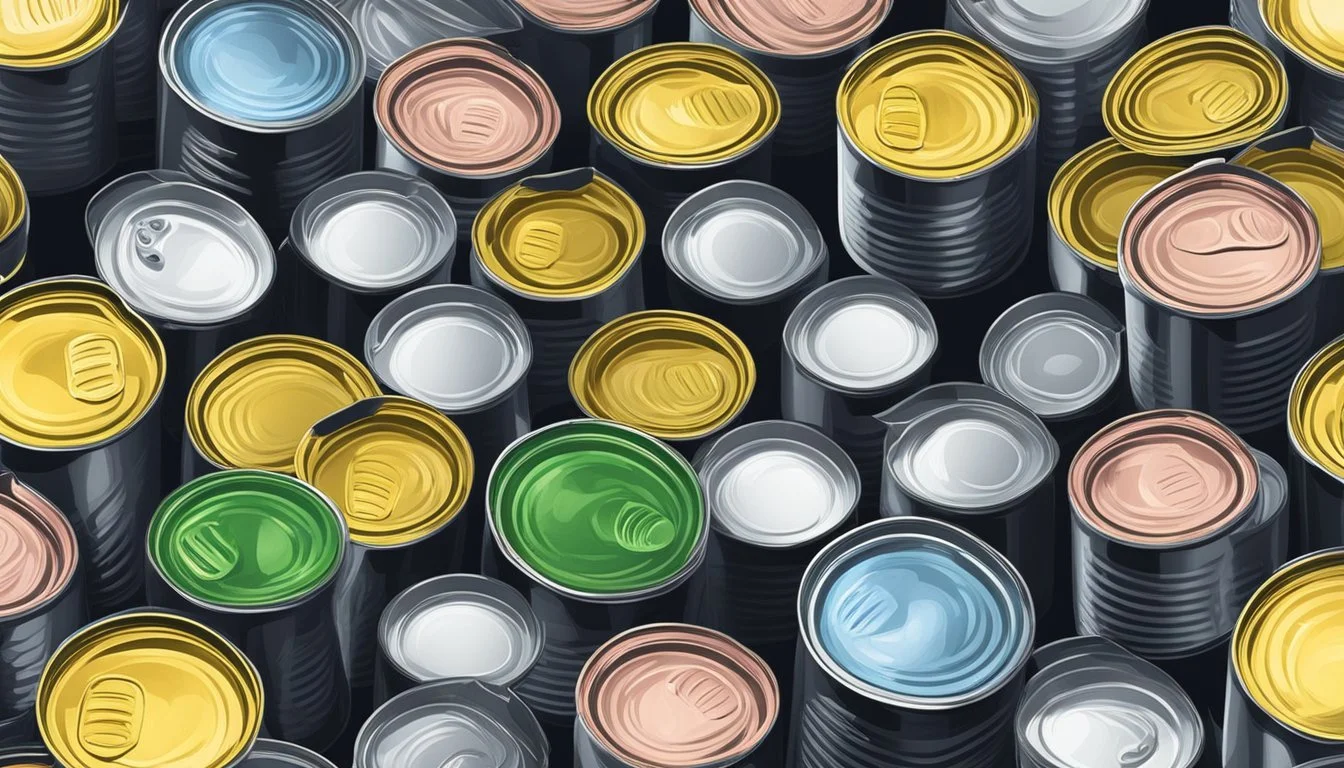Does Canned Tuna Go Bad?
Key Storage Tips and Shelf Life Explained
Canned tuna is a versatile and convenient pantry staple, but just like any other food item, it can go bad. Yes, canned tuna does eventually spoil, and understanding its shelf life can help consumers avoid foodborne illnesses. Commercially canned tuna typically lasts up to five years when stored properly, which makes it a reliable long-term food choice.
Proper storage conditions are crucial in maintaining the quality of canned tuna. A cool, dry place, away from direct sunlight, is ideal for extending its shelf life. Once a can is opened, transferring the tuna to an airtight container and refrigerating it will keep it good for up to 2-3 days.
Signs of spoilage in canned tuna include off-putting odors, changes in texture, and visible mold. Checking the can for any leaks, bulges, or rust before consumption is essential to ensure the tuna's quality and safety. By adhering to these guidelines, one can enjoy the benefits of canned tuna without the risk of spoilage.
Understanding Canned Tuna
Canned tuna is a versatile and nutritious food that offers various benefits and considerations. Key information includes different types of canned tuna, the canning process and preservation, and the nutritional benefits.
Types of Canned Tuna
Canned tuna comes in several varieties, each distinguished by its species and labeling. Common types include albacore, skipjack, and yellowfin.
Albacore tuna is often labeled as "white tuna" and has a milder flavor and firmer texture.
Skipjack tuna, frequently marketed as "light tuna," has a stronger flavor and softer texture.
Yellowfin tuna, another type of light tuna, is noted for its mild taste and is often found in gourmet canned varieties.
These types vary not only in taste and texture but also in mercury content, with albacore generally containing higher levels of mercury.
Canning Process and Preservation
The canning process involves multiple steps to ensure safety and longevity. Tuna is first cooked, then cleaned, and filleted. The fish is then packed into cans, often with oil, water, or brine.
Cans are sealed and heated to a high temperature to kill bacteria and other pathogens.
This process ensures that the canned tuna remains safe for consumption for a long period, sometimes several years.
However, once opened, canned tuna should be transferred to an airtight container and stored in the refrigerator, where it should be consumed within 2-3 days.
Nutritional Benefits
Canned tuna is a rich source of protein, providing essential amino acids necessary for muscle repair and growth.
It is also high in omega-3 fatty acids, which are beneficial for heart health and reducing inflammation.
In addition, canned tuna contains vital vitamins and minerals, including vitamin D, vitamin B12, selenium, and iodine.
Regular consumption of canned tuna can contribute to a balanced and nutritious diet, although attention should be paid to the type of tuna and its associated mercury content.
By selecting the appropriate type of tuna and following proper storage guidelines, individuals can enjoy the numerous benefits of this convenient and healthy food option.
Safety and Spoilage
Canned tuna is a convenient pantry staple, but it is crucial to know the signs of spoilage and understand the health risks associated with consuming spoiled tuna.
Signs of Spoilage
Recognizing spoilage in canned tuna is essential for food safety. Several indicators can help identify if the tuna has gone bad:
Foul Odor: Spoiled canned tuna often emits a rancid or sour smell. A strong, unpleasant odor is a clear sign that the tuna should not be consumed.
Unusual Texture: If the tuna appears slimy, mushy, or has developed a thick coating, it indicates spoilage. Fresh tuna should be firm and moist without being overly soft or sticky.
Visual Indicators: Look for signs of mold or discoloration on the surface of the tuna. The appearance of any off-color spots or an uncharacteristic sheen can signal that the tuna is no longer safe to eat.
Health Risks of Spoiled Tuna
Eating spoiled canned tuna can pose significant health risks due to the presence of contaminants and pathogens.
Foodborne Illnesses: Spoiled tuna can harbor bacteria like Salmonella and Listeria, which can cause severe foodborne illnesses. Consuming contaminated tuna can lead to symptoms such as nausea, vomiting, diarrhea, and stomach cramps.
Chemical Contaminants: Spoiled tuna may also contain harmful chemical substances like histamines. Improper storage conditions or prolonged exposure to heat can increase histamine levels, leading to scombroid poisoning, which manifests as a rash, headache, and gastrointestinal distress.
Mold and Toxic Substances: The growth of mold on canned tuna is another health concern. Mold can produce mycotoxins, dangerous compounds that pose a risk to human health if ingested.
Food Poisoning from Spoiled Canned Tuna
Food poisoning is a serious concern when it comes to spoiled canned tuna.
Symptoms: Common symptoms of food poisoning from spoiled tuna include abdominal pain, diarrhea, vomiting, and fever. These symptoms typically appear within hours of consumption and can last for several days.
Risk Factors: Certain groups, such as young children, elderly individuals, pregnant women, and those with compromised immune systems, are at higher risk of severe symptoms from food poisoning.
Prevention: Ensuring that canned tuna is stored in a cool, dry place away from direct sunlight can help minimize the risk of spoilage. Always transfer leftover tuna to an airtight container and refrigerate it, consuming it within 2-3 days to ensure freshness.
Awareness of the signs of spoilage and understanding the associated health risks is essential for preventing foodborne illnesses and ensuring safe consumption of canned tuna.
Storage Guidelines
Proper storage is essential for maintaining the quality and safety of canned tuna. Key factors include storage conditions, shelf life of unopened cans, handling of opened cans, and ways to extend shelf life through freezing.
Proper Storage Conditions
Canned tuna should be stored in a cool, dry place to prevent spoilage. Temperature fluctuations and exposure to direct sunlight can compromise the integrity of the can and its contents.
The ideal storage temperature ranges from 50-70°F (10-21°C). Keeping the environment consistent is crucial to avoid swelling or rusting of the cans.
Avoid stacking heavy items on top of canned tuna, as this can cause dents or punctures. Dents can lead to leaks, increasing the risk of contamination.
Shelf Life of Unopened Cans
When stored under optimal conditions, unopened canned tuna can have a shelf life of 3-5 years. It is important to regularly rotate your stock to ensure the oldest cans are used first.
Check the expiration date on the can and prioritize using cans that are closer to their end date. Storing cans at consistent temperatures helps maximize their shelf life.
Keep an eye out for any signs of can damage, such as rust, swelling, or dents, which can all indicate potential spoilage.
Handling Opened Canned Tuna
Once a can of tuna is opened, it should be handled with care to avoid contamination. Transfer any remaining tuna to a clean, air-tight container before refrigerating.
The refrigerator temperature should be set between 35°F (1.7°C) and 40°F (4.4°C). Consuming the tuna within 2-3 days will ensure it remains fresh and safe to eat.
Never leave opened canned tuna in the can, as it may adversely affect the taste and safety of the food.
Extending Shelf Life Through Freezing
To extend the shelf life of opened tuna, consider freezing it. Wrap the tuna tightly in plastic wrap, aluminum foil, or place it in an air-tight container before freezing.
Frozen tuna can last for up to 6 months if stored at 0°F (-18°C) or lower. This method maintains the quality of the tuna while preventing spoilage.
Ensure the tuna is properly labeled with the date before freezing to keep track of how long it has been stored.
Using Canned Tuna
Canned tuna offers versatility in the kitchen, both in terms of ingredients and convenience. Key considerations include how to incorporate it into recipes, understanding its taste and texture, and managing leftovers.
Incorporating into Recipes
Canned tuna can be used in a variety of dishes. It's often added to salads, such as a classic tuna salad with mayonnaise, celery, and onion, or more elaborate pasta salads.
Tuna casserole is another popular option, combining it with noodles, peas, and a creamy sauce. Sandwiches and wraps benefit from the easy protein boost that tuna provides, often mixed with crunchy vegetables and flavorful dressings.
Using canned tuna in hot dishes, like tuna melts or stir-fries, allows it to absorb other flavors, making it a versatile pantry staple.
Taste and Texture Considerations
The taste and texture of canned tuna can vary based on the type and brand. Light tuna typically has a milder flavor and firmer texture, while white tuna, such as albacore, is flakier and has a stronger taste.
If the tuna tastes too salty, it can be rinsed under cold water to reduce the sodium content. When using canned tuna in recipes, it's important to consider its existing flavor profile to avoid overpowering other ingredients.
Opt for water-packed tuna for a cleaner taste and oil-packed for richer recipes or added moisture.
Leftovers and Reuse
Leftover canned tuna should be stored properly to maintain freshness. Once opened, transfer any unused tuna to a clean, airtight container and refrigerate it.
Use the leftovers within 2-3 days to avoid spoilage. Leftover tuna can be repurposed in a variety of ways. Add it to mixed greens for a quick salad, fold it into scrambled eggs for a protein-rich breakfast, or incorporate it into dips and spreads for snacks.
Proper storage and creative reuse ensure that no tuna goes to waste, making it a practical ingredient for multiple meals.
Identifying and Dealing with Compromised Cans
Proper identification and management of compromised canned tuna can prevent health risks. This involves visual inspection of the cans, understanding the risks of damaged cans, and safe disposal practices.
Visual Inspection of Cans
Inspect cans thoroughly before purchase and use. Check for dents, leaks, bulges, and rust. Dented cans may compromise the seal and allow bacteria to enter. Leaks indicate a break in the container's integrity, risking contamination. Bulging cans can signal fermentation or bacterial activity, often indicating botulism. Rust on cans can weaken the structure, making them more prone to damage.
Look inside the can after opening. Tuna should appear consistent in color, without unusual discoloration. The texture should be firm. Any sliminess or mushiness can indicate spoilage.
Risks Associated with Damaged Cans
Damaged cans pose significant health risks. A compromised seal in dented cans can allow harmful bacteria to multiply. Bulging cans are particularly dangerous, often associated with Clostridium botulinum. Consuming tuna from such cans can lead to severe foodborne illness.
Spoiled tuna may emit a foul odor. A strong fishy smell is natural, but rancid or sour notes signal spoilage. Do not taste-test tuna if it appears or smells off, as ingestion of contaminated food can lead to severe illness.
Safe Disposal of Spoiled Canned Tuna
Dispose of any compromised or spoiled canned tuna safely. Ensure the can is sealed in a plastic bag to contain any leaks or odors. Place it in an outdoor trash bin away from living areas to avoid attracting pests. Avoid recycling spoiled food cans.
After handling a spoiled can, wash hands and surfaces thoroughly to prevent cross-contamination. If possible, alert the retailer where the purchase was made, as this can help in preventing further distribution of potentially unsafe canned goods.
Regular checks and proper storage of canned foods can mitigate risks. Store canned tuna in a cool, dry place, away from direct sunlight, and use within recommended timeframes after opening. This ensures food safety and quality.
Choosing and Buying Canned Tuna
Choosing the right canned tuna involves considering its type, reading its labels for freshness and safety, and evaluating the packaging. Here are key factors to help you make an informed decision.
Selecting the Right Type of Tuna
When selecting canned tuna, consider whether you prefer tuna packed in oil or water. Tuna packed in oil has a richer flavor and a smoother texture, making it ideal for salads and sandwiches. In contrast, water-packed tuna is lower in calories and fat, which might be preferable for those looking to reduce calorie intake or following a low-fat diet.
Additionally, identify the type of tuna. Light tuna is often from species like skipjack, and it is typically more affordable. Albacore, known as white tuna, has a milder flavor and firmer texture but can be more expensive.
Reading Labels for Freshness and Safety
Check the expiration date on the can to ensure you are purchasing a product with optimal freshness. Expiration dates help ensure the tuna is consumed while its quality is at its best.
Look for labels indicating whether the product is "dolphin-safe" or "sustainably-caught", which show the brand's commitment to environmentally friendly practices.
Avoid buying cans that are dented, rusted, or damaged, as these can compromise the integrity and safety of the tuna inside.
Evaluating the Packaging
The packaging of canned tuna can impact both its flavor and storage life. Tuna packed in oil may retain its flavor and moisture better over time, whereas tuna packed in water tends to be less calorie-dense.
Consider cans with easy-open tops if you might have issues with dexterity. Some brands offer tuna in pouches instead of cans, which can be more convenient and often have a fresher taste.
Finally, always store your canned tuna in a cool, dry place. Once opened, transfer any unused portion to a clean, airtight container and refrigerate it, aiming to use it within 2-3 days for the best quality.
Conclusion
Canned tuna remains a convenient and nutritious option, but it's important to handle it properly to maintain its quality and safety. While canned tuna is not as perishable as fresh tuna, it does eventually go bad.
Store unopened cans in a cool, dry place at room temperature, away from direct sunlight, to extend its shelf life.
Once opened, transfer the tuna to an airtight container and refrigerate it. Use it within 2-3 days to ensure it stays fresh and retains its nutrients. Checking the expiration date and inspecting the smell and appearance can help determine if the tuna is still good to eat.
Spoiled tuna can emit a sour or rancid odor, which indicates potential health risks if consumed. Always prioritize safety by being mindful of these signs and follow proper storage practices.






